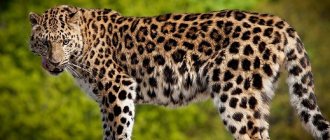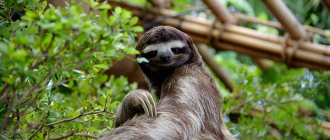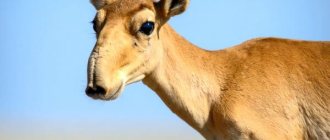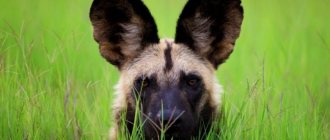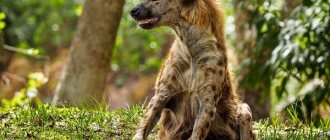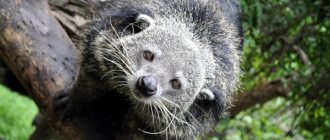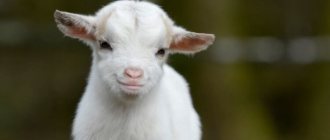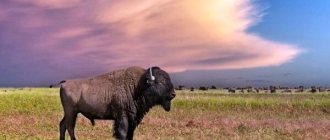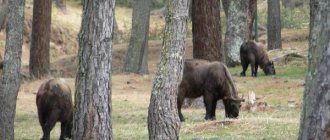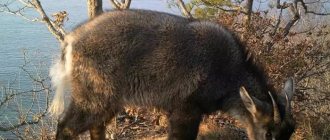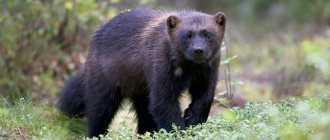The jaguar is a beautiful and powerful predator of the cat family, one of the five representatives of the genus Panthera (Panthera) and the only representative of this genus living in North and South America. The largest cat in the Americas, and the third largest in the world among all cats after the lion and tiger. They live in South and Central America, from Mexico to Paraguay and Argentina.
Jaguar - description
The name "jaguar" comes from the word "jaguar". This is the name of a large wild cat, larger than a wolf, in one of the indigenous languages of Brazil. The indigenous people of the Republic of Guyana in northern South America call the animal “jaguarete”. The Latin name of the species, onca (the jaguar belongs to the species Panthera Onca), comes from the Portuguese word 'onça', which the Portuguese used to name a large wild cat spotted in Brazil, larger in size than a lynx.
In science, the jaguar was first described by the famous Swedish naturalist Carl Linnaeus in his large-scale work “System of Nature” in 1758. Linnaeus gave the animal the scientific name Felis Onca. Throughout the 19th and 20th centuries, several subspecies of jaguar were observed based on a number of scientific studies and observations. In 1939, British zoologist Reginald Innes Pawcock identified 8 subspecies of jaguar, based on geographic location and morphological differences between the animals' skull structures. In 2005, scientists identified another subspecies, making the total number of subspecies 9. It was Reginald Poukok who classified the jaguar into the genus Panthera (Panthera), and hypothesized that it was closely related to the leopard (Panthera Pardus). Currently, the jaguar is considered a monotypic species (Panthera Onca).
In pre-Columbian America, for the Indians, the jaguar was the personification of strength and power, a sacred animal that was deeply revered and feared. In northern Peru, images of the animal were en masse applied to ceramics. In the mountains of Colombia, people dressed in skins during religious rituals. In the late Mayan civilization, the jaguar was considered a guide to the other world and a protector of the royal family. Several Mayan rulers added the nickname jaguar (b'alam in Mayan) to their name, and Balam is still a common surname among Mayan descendants. In Aztec mythology, the jaguar was the sacred animal of the chief deity Tezcatlipoca. The Aztecs had an elite military unit called the Jaguar Warriors, who dressed in skins and believed that the animal transferred some of its strength to them.
№11
The fossils found indicate that jaguars first appeared in Eurasia. These wild cats then crossed Beringia and came to America approximately 1.5 million years ago.
The average jaguar was much larger than its modern relatives. His body weight was approximately 15-20% greater. Fossils of ancient cats have been found in Florida, Maryland, Nebraska, Tennessee and Washington.
Dimensions and appearance
The jaguar is a powerful and muscular animal. Outwardly it resembles a leopard, but it is much larger in size, has a stockier build and powerful limbs. On average, the predator weighs about 56-96 kg. The largest males can reach a weight of 158 kg, while the smallest females weigh only 36 kg. Males are larger and heavier than females by about 10-20%. The size of the predator varies widely depending on its habitat: the further south the animal lives, the larger it is. Jaguars in central Mexico are relatively small, weighing on average no more than 50 kg. Animals in Venezuela and Brazil are much larger: males weigh on average about 95 kg, females - from 56 to 78 kg.
The length of the body from the nose to the base of the tail is on average 1.1-1.8 m. The jaguar has the shortest tail of all big cats, only 45 to 70 cm long. The paws are short, but powerful and massive. Compared to a tiger or lion, the jaguar's limbs are much shorter for a comparable body weight. The height of the animal at the withers is on average from 63 to 76 cm. Powerful short legs allow the predator to swim, climb and crawl well. The jaguar has a large head, a strong skull and very powerful jaws - in terms of bite force, of all cats, it is second only to the tiger and the lion.
The color of the animal is predominantly dark yellow, there are also reddish and brownish shades. The fur on the belly is white, light yellow or light gray. Black jaguars, also called black panthers, are less common than common yellow spotted jaguars because the black gene is recessive. White jaguars (albinos) are born very rarely.
The animal's skin is covered with dark spots in the shape of rosettes, which help the predator to successfully camouflage itself when hunting. The size of the spots and their shape vary significantly. The spots on the head, neck and tail are usually continuous. On the back and sides there are large ring-shaped rosettes with a small spot in the middle. Animals that live in the forest are usually much darker and smaller in size than their counterparts that live in open spaces. This is explained by the fact that there are fewer large prey in the forest.
Peculiarities
Among jaguars , melanistic animals are occasionally found that look very much like black panthers (as melanistic leopards are called). Their dark color is caused by an excess of dark pigment - melanin. The frequency of occurrence of such individuals is not related to environmental and geographical conditions: kittens of different colors may appear in one litter. In dark individuals, the fur is rather not black, but dark brown, on which, in bright sunlight and certain viewing angles, one can discern the spotted pattern characteristic of jaguars (photo 15). A melanistic female and a normal-colored male have lived in the Moscow Zoo for many years (photo 10-20).
Where does he live?
Currently, jaguars live in Central and South America. The animal is found in the following countries:
- Argentina
- Belize
- Bolivia
- Colombia
- Costa Rica
- Ecuador
- French Guiana
- Guatemala
- Guyana
- Honduras
- Nicaragua
- Panama
- Paraguay
- Suriname
- USA
- Venezuela
Previously, jaguars also lived in Uruguay and El Salvador, but now the animals have been completely exterminated in these countries. At the beginning of the 20th century, jaguars occupied an area of 19 million square kilometers, and were found even in California. By the beginning of the 21st century, the habitat of these animals had decreased to 8.75 million square kilometers; the main reductions in territory occurred in the southern states of the United States, southern Argentina, northern Mexico and northern Brazil.
Jaguars prefer dense tropical and subtropical forests, rain forests, grasslands and wetlands as habitats. Some individuals have been seen at altitudes of up to 3,800 meters above sea level, but jaguars generally avoid high altitudes. These predators are excellent swimmers and hunt in water, so they avoid dry places and love swamps and river beds with dense vegetation. Ideal conditions for a jaguar are a warm climate, plenty of vegetation, low, marshy land near a body of water, and plenty of prey around.
What does it eat?
Like other big cats, the jaguar is a natural predator and feeds exclusively on meat. Its diet is quite varied and includes at least 87 different species of animals. Prefers to hunt large animals weighing from 45 to 85 kg. His favorite prey:
- capybara
- ant-eater
- collared peccary
- nine-banded armadillo
- a wild boar
- white-nosed coati
Also, if possible, the jaguar is not averse to hunting American deer, crocodile caiman, South American tapir, maikong (savannah fox), Brazilian rabbit and agouti. With a lack of prey in the wild, the predator attacks livestock - horses, sheep, pigs and llamas. There is a known case where a jaguar killed and ate an American brown bear.
Thanks to its powerful jaws, the jaguar successfully hunts reptiles with shells - turtles and crocodiles. He kills the capybara by biting through the bones at the base of the skull; death from brain damage in this case occurs instantly. The predator can drag prey weighing up to 360 kg in its jaws, and even grinds large bones. In the wild, the animal is at the top of the food chain, and has no competitors.
The jaguar mainly hunts at dusk and at night. In some regions, such as the Amazon jungle, jaguars also hunt during the day. The predator traditionally attacks the prey from an ambush, mainly from behind or from the side, from a blind spot. It often jumps into the water after prey, because the jaguar is an excellent swimmer and is so strong that it can cope with large prey even in water. After a successful hunt, it drags the prey into the thickets or other secluded place. Usually eats prey from the head and neck.
For a small animal weighing up to 40 kg, the minimum daily amount of meat is at least 1.4 kg. A predator with an average weight of 50-60 kg eats an average of 2 kg of meat per day. In the wild, periods of successful hunting are irregular, so a predator can eat up to 25 kg of meat at a time. The predator prefers fresh meat and usually throws away the remains of its prey.
Economic significance for humans
Positive
Jaguars are predators and key species in the ecosystems they inhabit. Their skins and furs are sold for profit, despite the ban on hunting in most countries. Enforcement of laws protecting jaguars has improved in recent years. Jaguars are also an important source of income in ecotourism for local communities where there are opportunities to observe them.
Negative
Jaguars sometimes prey on cattle and other farm animals, leading to persecution by herders. Some countries, such as Brazil, Costa Rica, Guatemala, Mexico and Peru, have not banned hunting only for “problem” jaguars that repeatedly kill livestock. Bolivia allows trophy hunting of jaguars. Jaguars do not attack people without provocation.
Jaguar breeding and cubs
Females reach sexual maturity at 2 years, males only at 3-4 years. The mating season lasts all year round, but during periods of successful hunting, more cubs are born. Estrus in females lasts from 6 to 17 days out of a 37-day cycle. During the period of estrus, the female leaves her territory and attracts males with her voice and scent marks. Fights between males for a female are extremely rare; usually the female herself chooses a partner, going to his territory. After mating, the female returns to her own area. The male subsequently does not take any part in the fate of the offspring.
The female chooses a secluded place as a den - in thickets of vegetation, in a hollow tree, or in a cave. Pregnancy lasts on average 93-105 days, usually two kittens are born in one litter, with a maximum of 4 cubs. Once the kittens are born, the female will not tolerate a male being in close proximity because, like tigers, male jaguars may kill cubs to avoid future competition.
Kittens are born completely blind and helpless. The eyes open after 2 weeks. The female feeds the cubs with milk for up to 3 months; at the age of 6 months, the kittens begin to go hunting with their mother. Young jaguars stay with their mother until they are 1-2 years old, then go in search of their own territory. Young males become stray animals until they are able to conquer territory from their older relatives. In the wild, predators live up to 12-15 years, in captivity they can live up to 23 years, which makes them long-lived among other large cats.
Behavior
Jaguars are most active in the evening and at dawn, although they can be active at any time of the day. As a rule, they rest during the day. When resting, jaguars lie in deep shade, under dense vegetation, in caves or under large rocks. They also rest near river banks, and during the rainy season they are forced to perch on trees. Jaguars are highly dependent on water, especially during dry periods when they need to escape the water. These are solitary animals except during the breeding season.
Character
Like most cats, jaguars lead a solitary lifestyle, the only exception being females who live with grown cubs. Otherwise, predators meet with each other only to procreate, and each adult has its own territory. The territory of a female averages from 25 to 40 square kilometers, and may overlap with the territories of other predators. The territory of males is on average 2 times larger, and the territories of males do not intersect with each other. At the same time, the hunting grounds of several females may be located on the male’s territory.
Like other big cats except the snow leopard, jaguars are capable of growling. Their growl resembles a prolonged cough, which is interspersed with meows and grunts. Conflicts between individuals are usually associated with territorial disputes. A male jaguar will allow 2-3 females into his territory, but will not tolerate another male.
Jaguars are considered to be nocturnal hunters, but their favorite hunting time is dusk, before sunset and shortly before dawn. If there is prey, the predator is able to hunt during the day. The animal is very active and spends 50-60% of its time in motion. Jaguars attack people very rarely, and generally do not view people as food. This is due to the fact that jaguars practically do not hunt primates. However, with the reduction of the animals' natural habitat and food supply, animals have no choice and attacks on people are becoming more frequent.
№7
We all know that cats don't like water. However, this does not apply to jaguars. They easily debunk this stereotype. Jaguars are excellent swimmers who move very deftly in the water. They enter the water not only to move from one bank to another (in the case of rivers), but also to swim, cool off, and even hunt. It is worth noting that they hunt not only fish and small aquatic animals, but even crocodiles.
Jaguar species
Currently, there are 9 subspecies of jaguar, depending on the geographical habitat of the animals.
- Amazonian jaguar (Panthera onca onca). They live in the Amazon rain forests.
- Peruvian jaguar (Panthera onca peruvianus). Peru and Ecuador.
- Mexican jaguar (Panthera onca hernandesii). Mexico.
- Arizona jaguar (Panthera onca arizonsis). They live from Arizona to Sonora in Mexico.
- Central American jaguar (Panthera onca centralis). Central America.
- Goldman's jaguar (Panthera onca goldmani). Habitats: Mexico, Guatemala, Belize.
- Texas jaguars (Panthera onca veracrusis). Previously lived in Texas, exterminated.
- Brazilian jaguar (Panthera onca palustris). Southern Brazil.
- Paraguayan jaguar (Panthera onca paraguensis). Paraguay.
Threats
In many regions of their former distribution, jaguars were completely exterminated. This is due both to changes in the natural habitats of animals, and to fishing for the purpose of extracting their valuable skins, and to shooting by pastoralists who feared for their herds.
Jaguar in the reserve
Today, jaguars are included in the International Red Book and are protected in many countries. Limited shooting is permitted in Brazil, Mexico and Bolivia.
Population and conservation of the species
The population of jaguars in the wild is steadily declining. The main reasons are the constant narrowing of their natural habitat, the shooting of animals by farmers, and the high demand for skins. The animal is classified as a near threatened (NT) species in the Red Book of the International Union for Conservation of Nature (IUCN).
Since the beginning of the 20th century, jaguars have been a desirable prey for hunters and poachers for their valuable fur. The most significant damage to the population occurred in the 1960s, when more than 15,000 pelts were harvested annually from the Brazilian Amazon jungle. Since 1976, the international trade in jaguar skins has been prohibited, thanks to the Convention on International Trade in Endangered Species of Fauna and Flora. However, the shooting of animals by farmers and poachers still occurs.
Currently, jaguar hunting is prohibited in Argentina, Brazil, Colombia, French Guiana, Honduras, Nicaragua, Panama, Paraguay, Suriname, the United States and Venezuela. Restrictions apply in Peru and Guatemala. In Bolivia, only trophy hunting is allowed. In Ecuador and Guyana, animals are not protected in any way, and they are allowed to be hunted without restrictions.
Since the jaguar's range spans the borders of 18 countries, this makes joint, coordinated conservation efforts difficult. Since 2000, special zones have been introduced to preserve the jaguar population. At least 50 animals live on the territory of each zone. There are currently 51 such zones in 36 regions.
Natural enemies
The jaguar is at the top of the food chain and is not hunted by other animals in the wild. Predators can be injured when hunting prey that is too large - caimans, alligators, anacondas. Jaguars often share territory with pumas, the second largest feline predator in the New World. In central and northern America, pumas are larger in size than jaguars, so in these regions pumas pose a danger to predators and can take prey from them.
№6
These are loners who spend time with their relatives exclusively during the mating season, and then only with females. They are also territorial and will be aggressive towards strangers who enter their territory.
Males are more aggressive than females. Sometimes females may share territory with males or other females. Males never share territory with other males.
How is a jaguar different from a leopard and a cheetah?
Leopards and jaguars are very similar in appearance, and both belong to the genus Panthera (big cats). The two main differences between them are their size and habitat. Leopards live exclusively in the Old World - Africa, Asia and Europe. Jaguars live in North, South and Central America. Jaguars are much larger than leopards, more squat and massive, their legs and tail are shorter, and their jaws are more powerful. Both species hunt from ambush and lead a similar lifestyle, so they are not easy to distinguish.
Cheetahs are very different from both jaguars and leopards. Cheetahs belong to the genus of small cats, have a slender, lean, elongated body, and chase their prey while running. The cheetah is easily distinguished by its two black tear stripes on its face from the corners of its eyes to its mouth, its small head and long, thin legs. Unlike leopards and jaguars, cheetahs cannot retract their claws and do not climb trees well.
Color also differs among animals. The jaguar has a rich, bright yellow fur color and large black spots in the form of a rosette with a spot in the middle. The leopard has large ring-shaped spots all over its body, and its belly is noticeably lighter in color. The cheetah has small solid black spots all over its fur.
Nutrition
The black panther animal is a carnivorous predator. It hunts both small animals and large ones, several times its size, for example, zebras, antelopes, buffalos, and so on.
Given their remarkable ability to move through trees, panthers also find food here, for example in the form of monkeys. Domestic animals such as cows, horses and sheep are also sometimes attacked.
They hunt mainly from ambush, creeping up to the prey at a close distance, jumping out sharply and quickly catching up with their future food. Panthers immobilize and kill a hunted animal by biting its neck, and then lying down, with their front paws on the ground, they begin to slowly eat the meat, tearing it away from the victim’s carcass with sharp jerks of the head up and to the side.
The prey that the black panther does not eat is hidden in a tree as a reserve.
Often, in order to preserve food for the future, panthers lift the remains of an animal into trees, where they cannot be reached by predators that live exclusively on the ground. Adults feed their young offspring by dragging the carcass to them, but they never help small panthers tear off meat from a killed animal.
